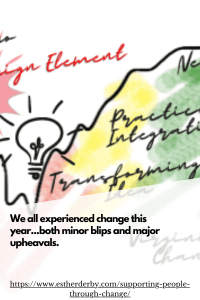We are all experiencing change right now. Minor blips and stunning upheavals. Routines at home and work. Expectations, assumptions, institutions—all are up for grabs. People ask, “As a leader in my organization, what can I do? How can I support people through change?
There are many things, of course. But the first starts with you
Start with Yourself

- Stay as calm as you can. Breathe. You will think better, and your calm may be contagious. This doesn’t mean you won’t have emotional responses. You will.
- Be present as you sit with your own emotions. Notice what you are feeling. Examine your perceived reasons. Ask yourself if they are grounded in reality. Consider alternate interpretations for those reasons. Verify. Emotions are important information. Don’t stuff them, don’t talk yourself out of them, and don’t let them hijack you.
Then, Support Others
- Expect high emotions in others. Don’t attempt to talk other people out of their emotions. It won’t work. You do not have to agree with the perceived reasons, however, to acknowledge emotions as valid. Validate and empathize, calmly.
- People crave–and need–information in times of change. Tell people what you know, and what you don’t yet know. Tell them when you’ll know more. Establish a rhythm for updates. Even letting people there’s no new information often helps. It communicates you haven’t forgotten about people and their concerns. If you’ve ever been stuck waiting for a delayed flight, you know this is true.
- Validate information. Verify interpretations. Clarify. Ask questions. Paraphrase in your own words and ask for confirmation. Explore boundary conditions, exceptions, intent. Go beyond Yes/No questions. You need more context.
- Pool information. Ask what other people have heard. Verify information. “I heard that, too,” is not verification. Name the source. Look for more than one source to confirm. Be careful about passing on unconfirmed information.
- Rumors will fill in any gaps. Acknowledge the rumors. Report back with verified information. Post it. This works on two levels. It eliminates some information gaps. It demonstrates that many rumors have little factual basis. This dampens over-reaction to unverified information.
- Remember your resources. You have access to courage, curiosity, empathy, ability to find data and reason about it. You can learn, and choose.
Look for Opportunity
Chaos presents opportunity. However, chaos can also destroy existing ways of thinking, and open doors to new ideas and ways of thinking, and about what to think. Where do you see a chance to move things in a better direction—at work and in the world? What factors contribute to the situation? What factors can you influence?
Find allies and support. Others will be looking for opportunity, too. Work with them.
Breathe. Be well and be kind to others and to yourself.








0 Comments